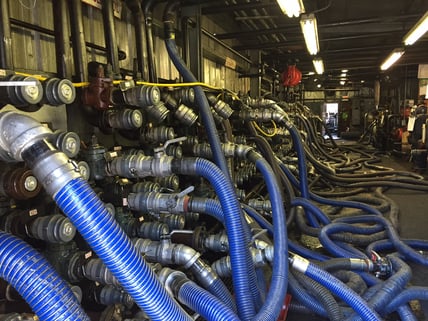
When it comes to transferring and handling fluids via hoses and piping, the ability to prevent the accidental release of product is an important factor to consider. It is particularly significant when frequent connections and disconnections involving expensive or hazardous fluids could cause spills, the loss of valuable media, or even spoiling of the media.
There are numerous substances that are recognized by the Environmental Protection Agency in its Emergency Planning and Community Right-to-Know Act (EPCRA) legislation as being hazardous to health and to the environment. The fines and penalties associated with violations of this legislation can be hefty and add up quickly since each day a violation continues to exist constitutes a separate violation.
Beyond the Environment
There are other reasons to exert tight control over the transport and handling of media beyond the environmental aspects. Certain liquid substances such as paint pigments are expensive media, meaning that any inadvertent spills – even if very small – can cause a big financial hit beyond the prospect of just the EPA's regulatory fines.
There is also a risk of product contamination if hoses and piping allow air to intrude and alter the physical properties of the fluids being handled. Hardening of the media can be a major concern in such cases.
Dry Disconnect Couplings as a Solution
With so much potential downside to fluid transfer and handling, the availability of better connecting devices is welcome. As it turns out, dry disconnect couplings are a very good solution for hoses and piping up to 4” in diameter. This type of coupling system is designed for quick and spill-free connection and disconnection of hoses and pipelines.
Over the past decade, a cam and groove design of dry disconnect products has become popular and been adopted by producers, transporters and handlers of a variety of media for example acids, chemicals, and petroleum products.
Design Simplicity. And Yet …
Anywhere connections and disconnections are taking place that involve the transfer of media they're likely to be good candidates for dry disconnect couplings. In keeping with its ability to "human-proof" the transfer of media, the basic design of cam and groove dry disconnect couplings is intuitive – in fact, it's the very essence of simplicity. Benefits to users include:
- Easy handling along with time-saving connecting and disconnecting – with no need to drain hoses or pipe systems.
- No loss of fluid spillage during connection or disconnection; the chance of accidental spillage is eliminated when properly operated.
- The valve cannot be opened until the unit is coupled.
Fortunately for users, there is also extensive compatibility between the cam and groove dry disconnect product choices available, allowing for the interchangeability of components.
For more information download Dixon’s white paper Making the Right Connection in Fluid Transfer Operations.
